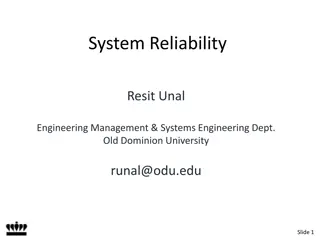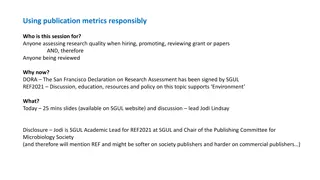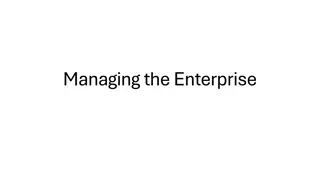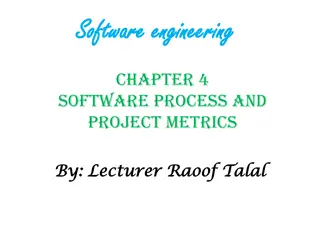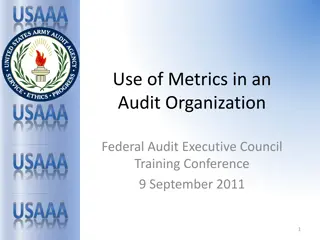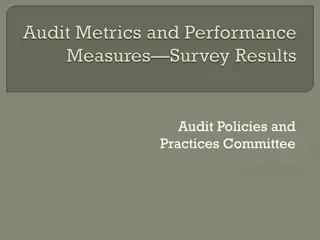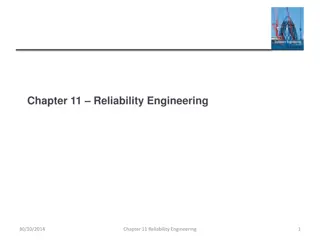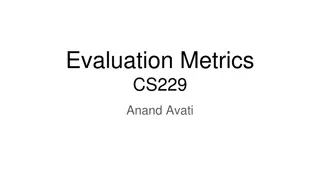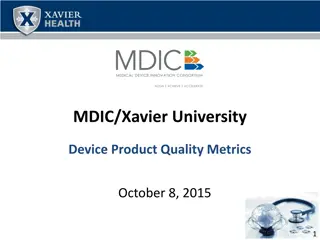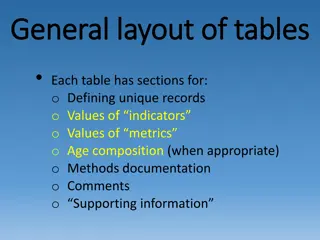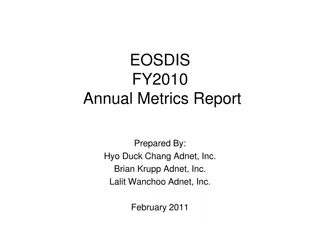Understanding Software Reliability Metrics
Software reliability is a vital aspect of system quality, ensuring that systems behave as expected and operate without frequent failures. Key concepts include fault, failure, and different time intervals like MTTF, MTTR, and MTBF. By measuring and understanding these metrics, we can assess the reliability of a software system accurately.
Download Presentation

Please find below an Image/Link to download the presentation.
The content on the website is provided AS IS for your information and personal use only. It may not be sold, licensed, or shared on other websites without obtaining consent from the author. Download presentation by click this link. If you encounter any issues during the download, it is possible that the publisher has removed the file from their server.
E N D
Presentation Transcript
Software Reliability Theory and Practice
Outline of the Chapter What is Reliability? Definitions of Software Reliability Factors Influencing Software Reliability Applications of Software Reliability Operational Profiles Reliability Models Summary 2
What is Reliability? Reliability is a broad concept. It is applied whenever we expect something to behave in a certain way. Reliability is one of the metrics that are used to measure quality. It is a user-oriented quality factor relating to system operation. Intuitively, if the users of a system rarely experience failure, the system is considered to be more reliable than one that fails more often. A system without faults is considered to be highly reliable. Constructing a correct system is a difficult task. Even an incorrect system may be considered to be reliable if the frequency of failure is acceptable. Key concepts in discussing reliability: Fault Failure Time Three kinds of time intervals: MTTR, MTTF, MTBF 3
What is Reliability? Failure A failure is said to occur if the observable outcome of a program execution is different from the expected outcome. Fault The adjudged cause of failure is called a fault. Example: A failure may be cause by a defective block of code. Time Time is a key concept in the formulation of reliability. If the time gap between two successive failures is short, we say that the system is less reliable. Two forms of time are considered. Execution time ( ) Calendar time (t) 4
What is Reliability? MTTF: Mean Time To Failure MTTR: Mean Time To Repair MTBF: Mean Time Between Failures (= MTTF + MTTR) 5
Mean Time To Failure (MTTF) Average time between two successive failures: observed over a large number of failures.
Mean Time to Repair (MTTR) Once failure occurs: additional time is lost to fix faults MTTR: measures average time it takes to fix faults.
Mean Time Between Failures (MTBF) We can combine MTTF and MTTR: to get an availability metric: MTBF=MTTF+MTTR MTBF of 100 hours would indicate Once a failure occurs, the next failure is expected after 100 hours of clock time.
What is Reliability? Two ways to measure reliability Counting failures in periodic intervals Observer the trend of cumulative failure count - ( ). Failure intensity Observe the trend of number of failures per unit time ( ). ( ) This denotes the total number of failures observed until execution time from the beginning of system execution. ( ) This denotes the number of failures observed per unittime after time units of executing the system from the beginning. This is also called the failure intensity at time . Relationship between ( ) and ( ) ( ) = d ( )/d 9
Definitions of Software Reliability First definition Software reliability is defined as the probability of failure-free operation of a software system for a specified time in a specified environment. Key elements of the above definition Probability of failure-free operation Length of time of failure-free operation A given execution environment Example The probability that a PC in a store is up and running for eight hours without crash is 0.99. Second definition Failure intensity is a measure of the reliability of a software system operating in a given environment. Example: An air traffic control system fails once in two years. Comparing the two The first puts emphasis on MTTF, whereas the second on count. 10
Factors Influencing Software Reliability A user s perception of the reliability of a software depends upon two categories of information. The number of faults present in the software. The ways users operate the system. This is known as the operational profile. The fault count in a system is influenced by the following. Size and complexity of code Characteristics of the development process used Education, experience, and training of development personnel Operational environment 11
Applications of Software Reliability Comparison of software engineering technologies What is the cost of adopting a technology? What is the return from the technology -- in terms of cost and quality? Measuring the progress of system testing Key question: How of testing has been done? The failure intensity measure tells us about the present quality of the system: high intensity means more tests are to be performed. Controlling the system in operation The amount of change to a software for maintenance affects its reliability. Thus the amount of change to be effected in one go is determined by how much reliability we are ready to potentially lose. Better insight into software development processes Quantification of quality gives us a better insight into the development processes. 12
Operational Profiles Developed at AT&T Bell Labs. An OP describes how actual users operate a system. An OP is a quantitative characterization of how a system will be used. Two ways to represent operational profiles Tabular Graphical Figure 15.2: Graphical representation of operational profile of a library information system. Table 15.1: An example of operational profile of a library information system. 13
Operational Profiles Use of operational profiles For accurate estimation of the reliability of a system, test the system in the same way it will be actually used in the field. Other uses of operational profiles Use an OP as a guiding document in designing user interfaces. The more frequently used operations should be easy to use. Use an OP to design an early version of a software for release. This contains the more frequently used operations. Use an OP to determine where to put more resources. 14
Reliability Models Main idea We develop mathematical models for ( ) and ( ). Basic assumptions in developing a reliability model Faults in the program are independent. Execution time between failures is large w.r.t. instruction execution time. Potential test space covers its use space. The set of inputs per test run is randomly chosen. The fault causing a failure is immediately fixed or else its re-occurrence is not counted again. 15
Reliability Models Intuitive idea As we observe another system failure and the corresponding fault is fixed, there will be fewer number of faults remaining in the system and the failure intensity will be smaller with each fault fixed. In other words, as the cumulative failure count increases, the failure intensity decreases. Two decrement processes Decrement process 1 The decrease in failure intensity after observing a failure and fixing the corresponding fault is constant. This gives us the Basic model. Decrement process 2 The decrease in failure intensity after observing a failure and fixing the corresponding fault is smaller than the previous decrease. This gives us the Logarithmic model. 16
Reliability Models Parameters of the models 0: The initial failure intensity observed at the beginning of system testing. v0: The total number of system failures that we expect to observe over infinite time starting from the beginning of system testing. : A parameter representing n0n-linear drop in failure intensity in the Logarithmic model. Figure 15.3: Failure intensity as a function of cumulative failures . 17
Reliability Models Basic model Assumption: ( ) = 0 (1 - /v0) d ( )/d = 0 (1 - ( )/v0) ( ) = 0 (1 - /v0) ( ) = 0.e - 0 /v0 Logarithmic model Assumption: ( ) = 0e- d ( )/d = 0e- ( ) ( ) = ln( 0 + 1)/ ( ) = 0/( 0 + 1) Figure 15.4: Failure intensity as a function of execution time ( 0 = 9 failures/unit time,v0 = 500 failures, = 0.0075). 18
Summary Reliability is a user-oriented quality factor relating to system operation. The chapter introduced the following. Fault and failure Execution and calendar time Time interval between failures Failures in periodic intervals Failure intensity Software reliability was defined in two ways. The probability of failure-free operation of a system for a specified time in a given environment. Failure intensity is a measure of reliability. User s perception of reliability: The number of faults in a system. How a user operates a system. The number of faults in a system is influenced by the following: Size and complexity of code. Development process. Personnel quality. Operational environment Operational profile A quantitative characterization of how actual users operate a system. Tabular and graphical representation Applications of reliability metric Reliability models Six assumptions Two models Basic Logarithmic 20`
Questions? 21



